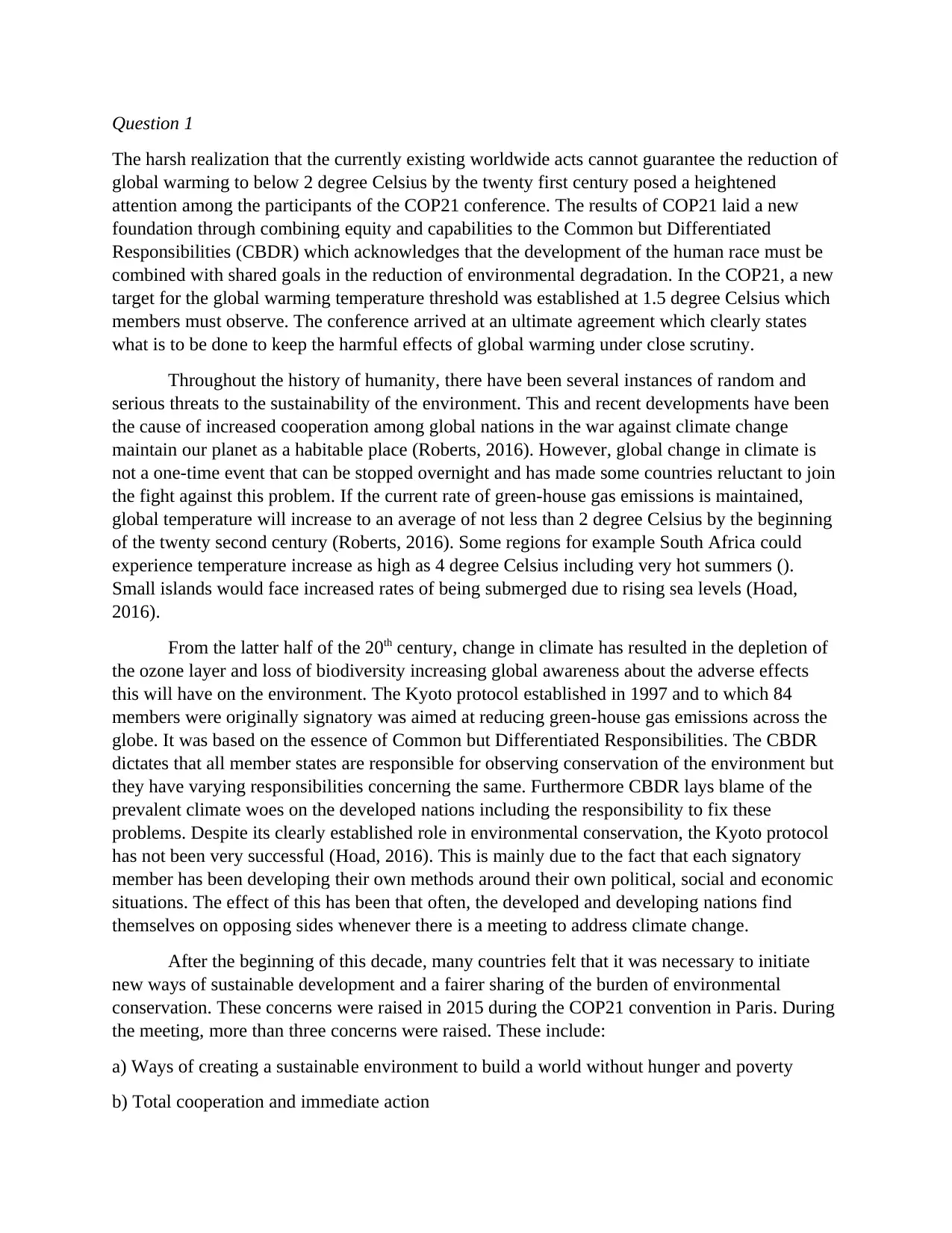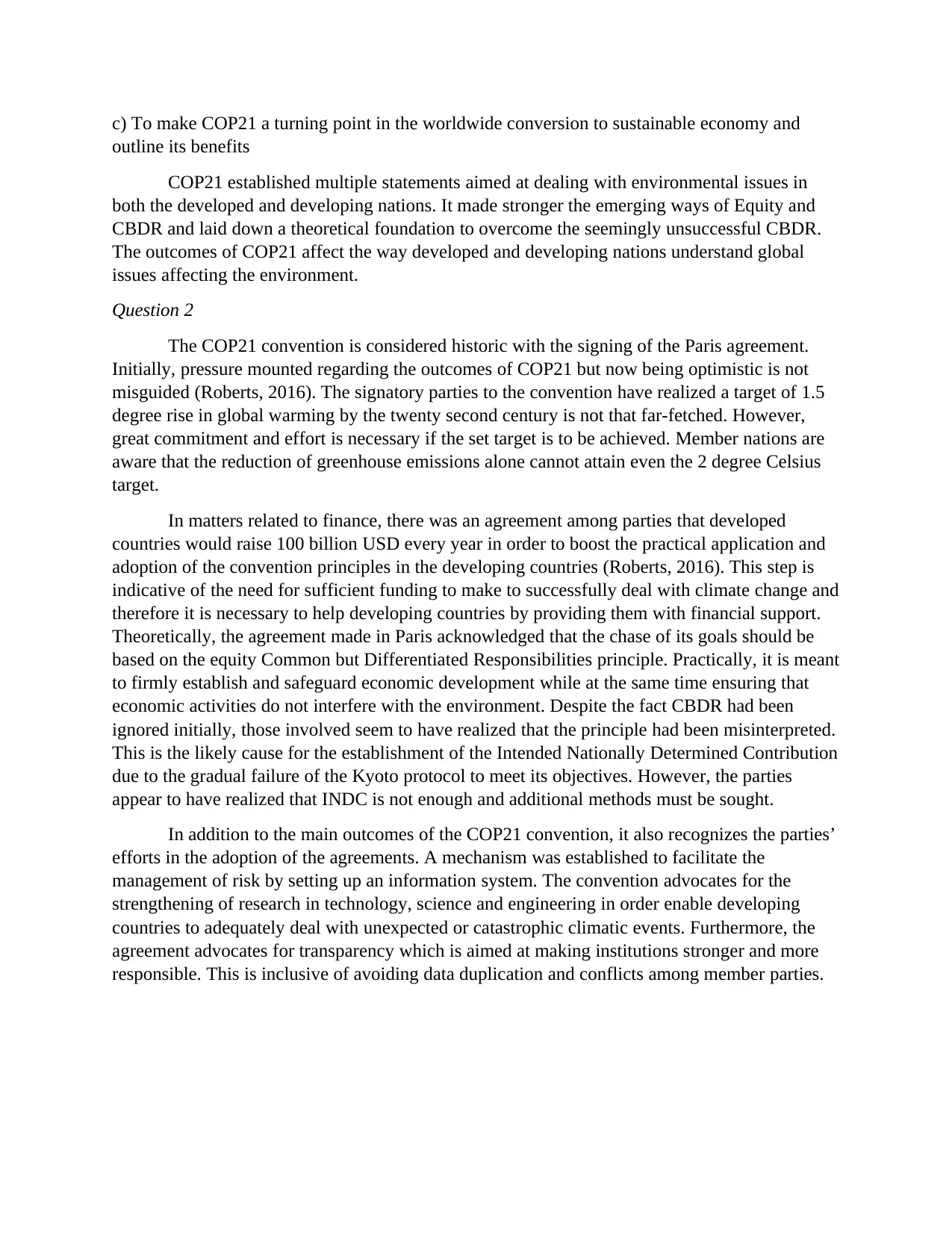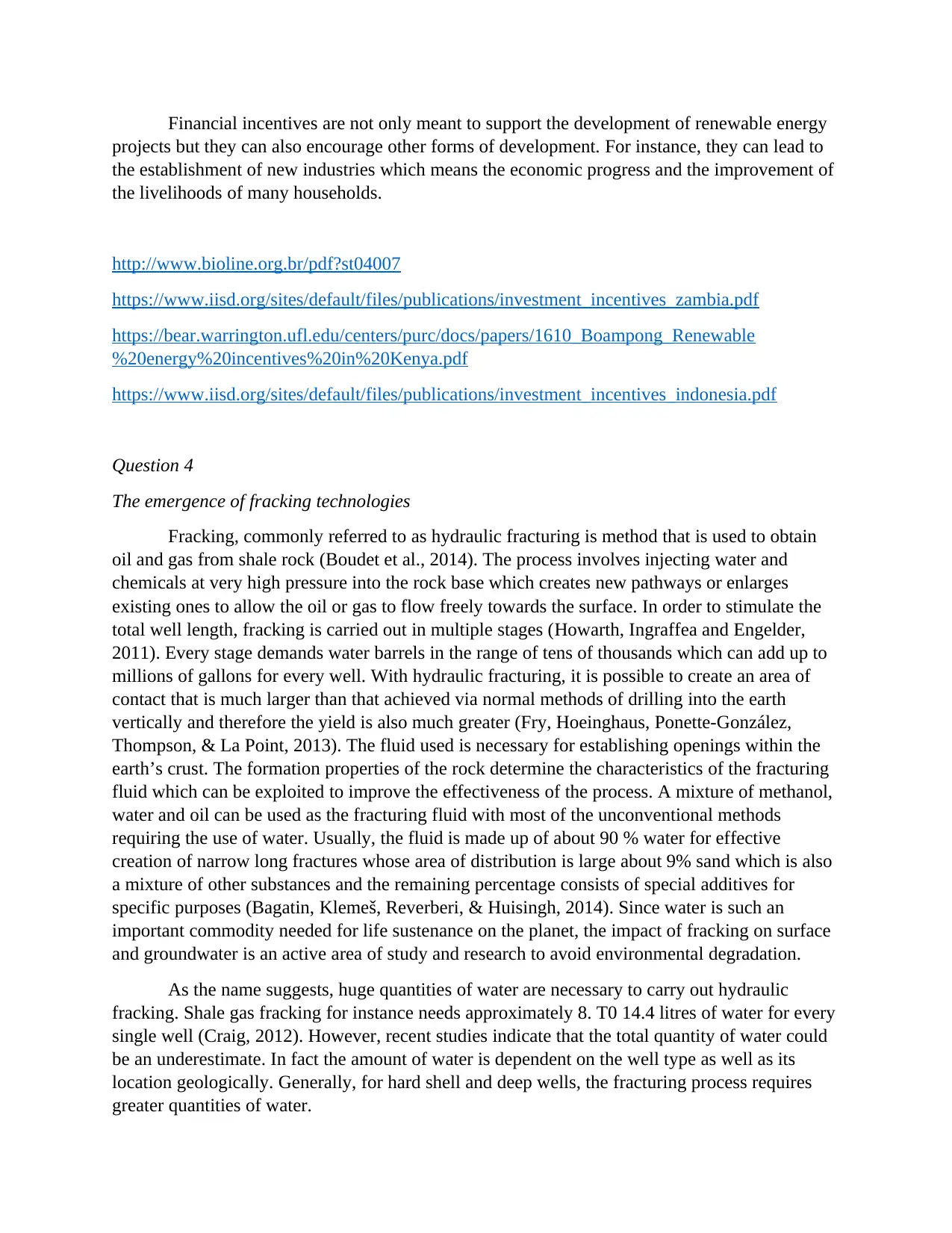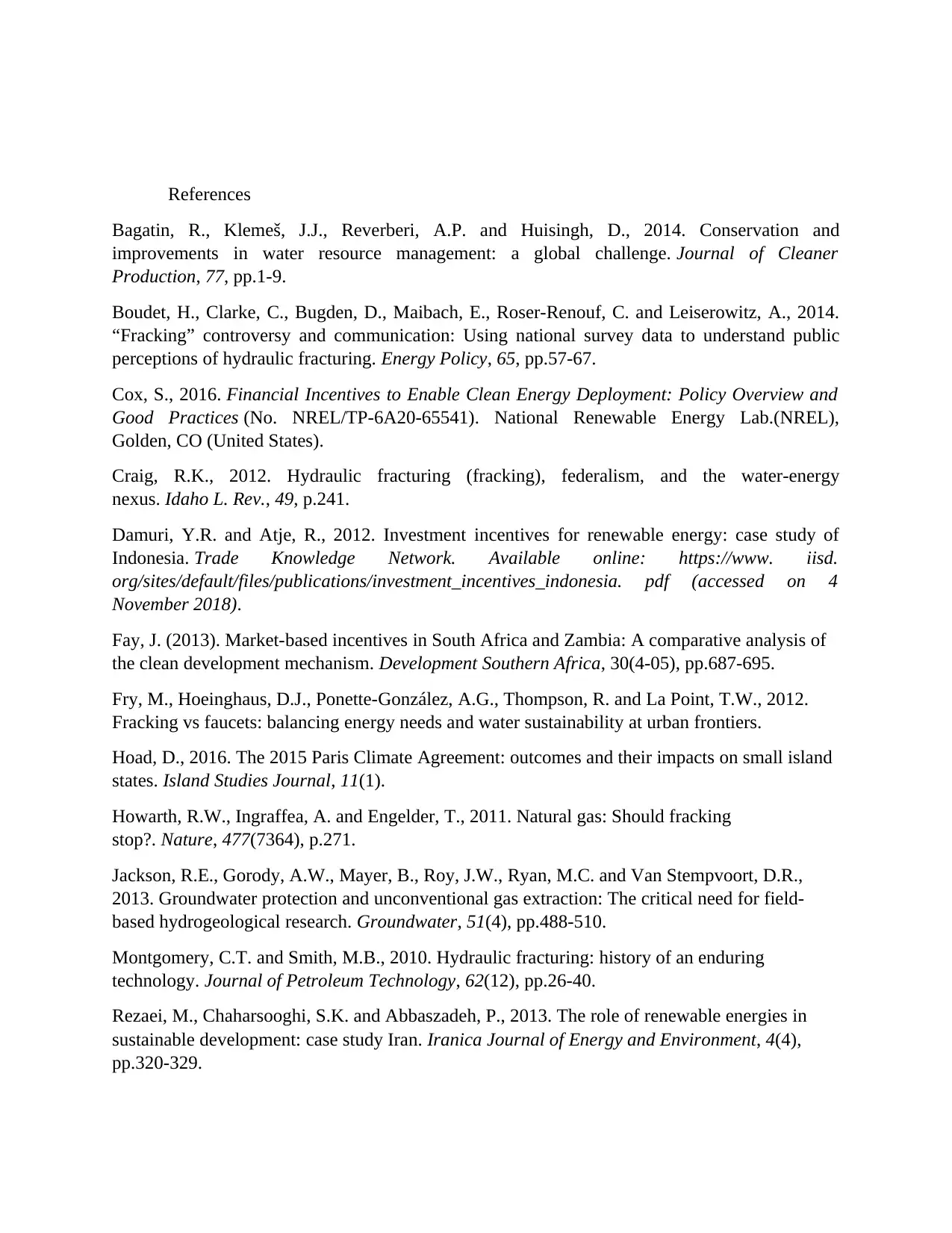The Role of Renewable Energies in Sustainable Development
VerifiedAdded on 2023/01/18
|8
|2831
|64
AI Summary
This article discusses the significance of renewable energy in promoting sustainable development and its positive impact on the environment and economy. It highlights the need for incentives and financial support to increase investment in renewable energy, as well as the role of governments in implementing favorable regulations. The article also explores the various financial incentives and policies that can encourage the use and production of renewable energy.
Contribute Materials
Your contribution can guide someone’s learning journey. Share your
documents today.

Secure Best Marks with AI Grader
Need help grading? Try our AI Grader for instant feedback on your assignments.

Question 1
The harsh realization that the currently existing worldwide acts cannot guarantee the reduction of
global warming to below 2 degree Celsius by the twenty first century posed a heightened
attention among the participants of the COP21 conference. The results of COP21 laid a new
foundation through combining equity and capabilities to the Common but Differentiated
Responsibilities (CBDR) which acknowledges that the development of the human race must be
combined with shared goals in the reduction of environmental degradation. In the COP21, a new
target for the global warming temperature threshold was established at 1.5 degree Celsius which
members must observe. The conference arrived at an ultimate agreement which clearly states
what is to be done to keep the harmful effects of global warming under close scrutiny.
Throughout the history of humanity, there have been several instances of random and
serious threats to the sustainability of the environment. This and recent developments have been
the cause of increased cooperation among global nations in the war against climate change
maintain our planet as a habitable place (Roberts, 2016). However, global change in climate is
not a one-time event that can be stopped overnight and has made some countries reluctant to join
the fight against this problem. If the current rate of green-house gas emissions is maintained,
global temperature will increase to an average of not less than 2 degree Celsius by the beginning
of the twenty second century (Roberts, 2016). Some regions for example South Africa could
experience temperature increase as high as 4 degree Celsius including very hot summers ().
Small islands would face increased rates of being submerged due to rising sea levels (Hoad,
2016).
From the latter half of the 20th century, change in climate has resulted in the depletion of
the ozone layer and loss of biodiversity increasing global awareness about the adverse effects
this will have on the environment. The Kyoto protocol established in 1997 and to which 84
members were originally signatory was aimed at reducing green-house gas emissions across the
globe. It was based on the essence of Common but Differentiated Responsibilities. The CBDR
dictates that all member states are responsible for observing conservation of the environment but
they have varying responsibilities concerning the same. Furthermore CBDR lays blame of the
prevalent climate woes on the developed nations including the responsibility to fix these
problems. Despite its clearly established role in environmental conservation, the Kyoto protocol
has not been very successful (Hoad, 2016). This is mainly due to the fact that each signatory
member has been developing their own methods around their own political, social and economic
situations. The effect of this has been that often, the developed and developing nations find
themselves on opposing sides whenever there is a meeting to address climate change.
After the beginning of this decade, many countries felt that it was necessary to initiate
new ways of sustainable development and a fairer sharing of the burden of environmental
conservation. These concerns were raised in 2015 during the COP21 convention in Paris. During
the meeting, more than three concerns were raised. These include:
a) Ways of creating a sustainable environment to build a world without hunger and poverty
b) Total cooperation and immediate action
The harsh realization that the currently existing worldwide acts cannot guarantee the reduction of
global warming to below 2 degree Celsius by the twenty first century posed a heightened
attention among the participants of the COP21 conference. The results of COP21 laid a new
foundation through combining equity and capabilities to the Common but Differentiated
Responsibilities (CBDR) which acknowledges that the development of the human race must be
combined with shared goals in the reduction of environmental degradation. In the COP21, a new
target for the global warming temperature threshold was established at 1.5 degree Celsius which
members must observe. The conference arrived at an ultimate agreement which clearly states
what is to be done to keep the harmful effects of global warming under close scrutiny.
Throughout the history of humanity, there have been several instances of random and
serious threats to the sustainability of the environment. This and recent developments have been
the cause of increased cooperation among global nations in the war against climate change
maintain our planet as a habitable place (Roberts, 2016). However, global change in climate is
not a one-time event that can be stopped overnight and has made some countries reluctant to join
the fight against this problem. If the current rate of green-house gas emissions is maintained,
global temperature will increase to an average of not less than 2 degree Celsius by the beginning
of the twenty second century (Roberts, 2016). Some regions for example South Africa could
experience temperature increase as high as 4 degree Celsius including very hot summers ().
Small islands would face increased rates of being submerged due to rising sea levels (Hoad,
2016).
From the latter half of the 20th century, change in climate has resulted in the depletion of
the ozone layer and loss of biodiversity increasing global awareness about the adverse effects
this will have on the environment. The Kyoto protocol established in 1997 and to which 84
members were originally signatory was aimed at reducing green-house gas emissions across the
globe. It was based on the essence of Common but Differentiated Responsibilities. The CBDR
dictates that all member states are responsible for observing conservation of the environment but
they have varying responsibilities concerning the same. Furthermore CBDR lays blame of the
prevalent climate woes on the developed nations including the responsibility to fix these
problems. Despite its clearly established role in environmental conservation, the Kyoto protocol
has not been very successful (Hoad, 2016). This is mainly due to the fact that each signatory
member has been developing their own methods around their own political, social and economic
situations. The effect of this has been that often, the developed and developing nations find
themselves on opposing sides whenever there is a meeting to address climate change.
After the beginning of this decade, many countries felt that it was necessary to initiate
new ways of sustainable development and a fairer sharing of the burden of environmental
conservation. These concerns were raised in 2015 during the COP21 convention in Paris. During
the meeting, more than three concerns were raised. These include:
a) Ways of creating a sustainable environment to build a world without hunger and poverty
b) Total cooperation and immediate action

c) To make COP21 a turning point in the worldwide conversion to sustainable economy and
outline its benefits
COP21 established multiple statements aimed at dealing with environmental issues in
both the developed and developing nations. It made stronger the emerging ways of Equity and
CBDR and laid down a theoretical foundation to overcome the seemingly unsuccessful CBDR.
The outcomes of COP21 affect the way developed and developing nations understand global
issues affecting the environment.
Question 2
The COP21 convention is considered historic with the signing of the Paris agreement.
Initially, pressure mounted regarding the outcomes of COP21 but now being optimistic is not
misguided (Roberts, 2016). The signatory parties to the convention have realized a target of 1.5
degree rise in global warming by the twenty second century is not that far-fetched. However,
great commitment and effort is necessary if the set target is to be achieved. Member nations are
aware that the reduction of greenhouse emissions alone cannot attain even the 2 degree Celsius
target.
In matters related to finance, there was an agreement among parties that developed
countries would raise 100 billion USD every year in order to boost the practical application and
adoption of the convention principles in the developing countries (Roberts, 2016). This step is
indicative of the need for sufficient funding to make to successfully deal with climate change and
therefore it is necessary to help developing countries by providing them with financial support.
Theoretically, the agreement made in Paris acknowledged that the chase of its goals should be
based on the equity Common but Differentiated Responsibilities principle. Practically, it is meant
to firmly establish and safeguard economic development while at the same time ensuring that
economic activities do not interfere with the environment. Despite the fact CBDR had been
ignored initially, those involved seem to have realized that the principle had been misinterpreted.
This is the likely cause for the establishment of the Intended Nationally Determined Contribution
due to the gradual failure of the Kyoto protocol to meet its objectives. However, the parties
appear to have realized that INDC is not enough and additional methods must be sought.
In addition to the main outcomes of the COP21 convention, it also recognizes the parties’
efforts in the adoption of the agreements. A mechanism was established to facilitate the
management of risk by setting up an information system. The convention advocates for the
strengthening of research in technology, science and engineering in order enable developing
countries to adequately deal with unexpected or catastrophic climatic events. Furthermore, the
agreement advocates for transparency which is aimed at making institutions stronger and more
responsible. This is inclusive of avoiding data duplication and conflicts among member parties.
outline its benefits
COP21 established multiple statements aimed at dealing with environmental issues in
both the developed and developing nations. It made stronger the emerging ways of Equity and
CBDR and laid down a theoretical foundation to overcome the seemingly unsuccessful CBDR.
The outcomes of COP21 affect the way developed and developing nations understand global
issues affecting the environment.
Question 2
The COP21 convention is considered historic with the signing of the Paris agreement.
Initially, pressure mounted regarding the outcomes of COP21 but now being optimistic is not
misguided (Roberts, 2016). The signatory parties to the convention have realized a target of 1.5
degree rise in global warming by the twenty second century is not that far-fetched. However,
great commitment and effort is necessary if the set target is to be achieved. Member nations are
aware that the reduction of greenhouse emissions alone cannot attain even the 2 degree Celsius
target.
In matters related to finance, there was an agreement among parties that developed
countries would raise 100 billion USD every year in order to boost the practical application and
adoption of the convention principles in the developing countries (Roberts, 2016). This step is
indicative of the need for sufficient funding to make to successfully deal with climate change and
therefore it is necessary to help developing countries by providing them with financial support.
Theoretically, the agreement made in Paris acknowledged that the chase of its goals should be
based on the equity Common but Differentiated Responsibilities principle. Practically, it is meant
to firmly establish and safeguard economic development while at the same time ensuring that
economic activities do not interfere with the environment. Despite the fact CBDR had been
ignored initially, those involved seem to have realized that the principle had been misinterpreted.
This is the likely cause for the establishment of the Intended Nationally Determined Contribution
due to the gradual failure of the Kyoto protocol to meet its objectives. However, the parties
appear to have realized that INDC is not enough and additional methods must be sought.
In addition to the main outcomes of the COP21 convention, it also recognizes the parties’
efforts in the adoption of the agreements. A mechanism was established to facilitate the
management of risk by setting up an information system. The convention advocates for the
strengthening of research in technology, science and engineering in order enable developing
countries to adequately deal with unexpected or catastrophic climatic events. Furthermore, the
agreement advocates for transparency which is aimed at making institutions stronger and more
responsible. This is inclusive of avoiding data duplication and conflicts among member parties.

Question 3
The Role of Renewable Energies in Sustainable Development
Several factors such as the limited nature of fossil fuels, their high prices and the many negative
impacts they have on the environment have made many countries realize the importance of
shifting towards a contemporary structure that allows permanent energy supply, protection of the
environment and the improvement of the efficiency of energy production systems (Rezaei,
Chaharsooghi and Abbaszadeh, 2013). Thus keeping a track of energy production and
sustainability is crucial.
There has been public concern regarding the heavy consequences on the environment
brought about by the use of fossil fuels. As a result of this, the use of renewable energy has been
the goal in many countries lately. It is an established fact that the use of renewable energy
sources such as wind and solar can significantly lower the rate of global warming, boost local
processing factories, promote local engineering sectors and lower dependence on imported
energy for any country (Fay, 2013). Sustainable development is aimed at service delivery in a
way that satisfies human needs while at the same time preserving the integrity of the
environment for as long as possible. Renewable is the key to the attainment of sustainable
development.
Renewable energy contribution to the total energy supply for many countries including
Iran is still very small. This indicates the need for incentives in order to increase the investment
in this energy sector, especially by private investors which could rapidly revolutionize the sector
(Damuri and Atje, 2012). Globally, governments have begun to deploy several financial policies
aimed at encouraging the use of renewable energy as well as exploring additional production
methods (Cox, 2016). Local and regional governments have a very crucial role to play regarding
the implementation of various energy policies by initiating favorable regulations and the issuance
of permits. Several regional governments have introduced schemes that greatly ease the
bureaucratic procedures involved in project initiation which is a major hindrance for progress
(Cox, 2016).
Changing tax policies have led to the accelerated deployment and use of renewable
energy. These include individual tax incentives which are tax credits given for the development
of a renewable energy system or energy efficient system (Walimwipi, 2012). Value added tax
incentives which are directed at eliminating or lessening sales taxes for renewable energy
technologies have been introduced. Loan grants, credit boosts and guarantees can also be used to
encourage renewable energy use and production (Walimwipi, 2012). Loan incentives include
loan guarantees which establish reduced interest rates through the assurance to the lender that the
loan will be repaid in the case the borrower defaults. Other loan incentives are property based
and are implemented to fund renewable energy firms operating in small-scales. In some countries
focused on the electrification of rural areas such as Kenya and Zambia, there may be full capital
provision for renewable energy projects aimed at the promotion of local electricity access.
The Role of Renewable Energies in Sustainable Development
Several factors such as the limited nature of fossil fuels, their high prices and the many negative
impacts they have on the environment have made many countries realize the importance of
shifting towards a contemporary structure that allows permanent energy supply, protection of the
environment and the improvement of the efficiency of energy production systems (Rezaei,
Chaharsooghi and Abbaszadeh, 2013). Thus keeping a track of energy production and
sustainability is crucial.
There has been public concern regarding the heavy consequences on the environment
brought about by the use of fossil fuels. As a result of this, the use of renewable energy has been
the goal in many countries lately. It is an established fact that the use of renewable energy
sources such as wind and solar can significantly lower the rate of global warming, boost local
processing factories, promote local engineering sectors and lower dependence on imported
energy for any country (Fay, 2013). Sustainable development is aimed at service delivery in a
way that satisfies human needs while at the same time preserving the integrity of the
environment for as long as possible. Renewable is the key to the attainment of sustainable
development.
Renewable energy contribution to the total energy supply for many countries including
Iran is still very small. This indicates the need for incentives in order to increase the investment
in this energy sector, especially by private investors which could rapidly revolutionize the sector
(Damuri and Atje, 2012). Globally, governments have begun to deploy several financial policies
aimed at encouraging the use of renewable energy as well as exploring additional production
methods (Cox, 2016). Local and regional governments have a very crucial role to play regarding
the implementation of various energy policies by initiating favorable regulations and the issuance
of permits. Several regional governments have introduced schemes that greatly ease the
bureaucratic procedures involved in project initiation which is a major hindrance for progress
(Cox, 2016).
Changing tax policies have led to the accelerated deployment and use of renewable
energy. These include individual tax incentives which are tax credits given for the development
of a renewable energy system or energy efficient system (Walimwipi, 2012). Value added tax
incentives which are directed at eliminating or lessening sales taxes for renewable energy
technologies have been introduced. Loan grants, credit boosts and guarantees can also be used to
encourage renewable energy use and production (Walimwipi, 2012). Loan incentives include
loan guarantees which establish reduced interest rates through the assurance to the lender that the
loan will be repaid in the case the borrower defaults. Other loan incentives are property based
and are implemented to fund renewable energy firms operating in small-scales. In some countries
focused on the electrification of rural areas such as Kenya and Zambia, there may be full capital
provision for renewable energy projects aimed at the promotion of local electricity access.
Secure Best Marks with AI Grader
Need help grading? Try our AI Grader for instant feedback on your assignments.

Financial incentives are not only meant to support the development of renewable energy
projects but they can also encourage other forms of development. For instance, they can lead to
the establishment of new industries which means the economic progress and the improvement of
the livelihoods of many households.
http://www.bioline.org.br/pdf?st04007
https://www.iisd.org/sites/default/files/publications/investment_incentives_zambia.pdf
https://bear.warrington.ufl.edu/centers/purc/docs/papers/1610_Boampong_Renewable
%20energy%20incentives%20in%20Kenya.pdf
https://www.iisd.org/sites/default/files/publications/investment_incentives_indonesia.pdf
Question 4
The emergence of fracking technologies
Fracking, commonly referred to as hydraulic fracturing is method that is used to obtain
oil and gas from shale rock (Boudet et al., 2014). The process involves injecting water and
chemicals at very high pressure into the rock base which creates new pathways or enlarges
existing ones to allow the oil or gas to flow freely towards the surface. In order to stimulate the
total well length, fracking is carried out in multiple stages (Howarth, Ingraffea and Engelder,
2011). Every stage demands water barrels in the range of tens of thousands which can add up to
millions of gallons for every well. With hydraulic fracturing, it is possible to create an area of
contact that is much larger than that achieved via normal methods of drilling into the earth
vertically and therefore the yield is also much greater (Fry, Hoeinghaus, Ponette-González,
Thompson, & La Point, 2013). The fluid used is necessary for establishing openings within the
earth’s crust. The formation properties of the rock determine the characteristics of the fracturing
fluid which can be exploited to improve the effectiveness of the process. A mixture of methanol,
water and oil can be used as the fracturing fluid with most of the unconventional methods
requiring the use of water. Usually, the fluid is made up of about 90 % water for effective
creation of narrow long fractures whose area of distribution is large about 9% sand which is also
a mixture of other substances and the remaining percentage consists of special additives for
specific purposes (Bagatin, Klemeš, Reverberi, & Huisingh, 2014). Since water is such an
important commodity needed for life sustenance on the planet, the impact of fracking on surface
and groundwater is an active area of study and research to avoid environmental degradation.
As the name suggests, huge quantities of water are necessary to carry out hydraulic
fracking. Shale gas fracking for instance needs approximately 8. T0 14.4 litres of water for every
single well (Craig, 2012). However, recent studies indicate that the total quantity of water could
be an underestimate. In fact the amount of water is dependent on the well type as well as its
location geologically. Generally, for hard shell and deep wells, the fracturing process requires
greater quantities of water.
projects but they can also encourage other forms of development. For instance, they can lead to
the establishment of new industries which means the economic progress and the improvement of
the livelihoods of many households.
http://www.bioline.org.br/pdf?st04007
https://www.iisd.org/sites/default/files/publications/investment_incentives_zambia.pdf
https://bear.warrington.ufl.edu/centers/purc/docs/papers/1610_Boampong_Renewable
%20energy%20incentives%20in%20Kenya.pdf
https://www.iisd.org/sites/default/files/publications/investment_incentives_indonesia.pdf
Question 4
The emergence of fracking technologies
Fracking, commonly referred to as hydraulic fracturing is method that is used to obtain
oil and gas from shale rock (Boudet et al., 2014). The process involves injecting water and
chemicals at very high pressure into the rock base which creates new pathways or enlarges
existing ones to allow the oil or gas to flow freely towards the surface. In order to stimulate the
total well length, fracking is carried out in multiple stages (Howarth, Ingraffea and Engelder,
2011). Every stage demands water barrels in the range of tens of thousands which can add up to
millions of gallons for every well. With hydraulic fracturing, it is possible to create an area of
contact that is much larger than that achieved via normal methods of drilling into the earth
vertically and therefore the yield is also much greater (Fry, Hoeinghaus, Ponette-González,
Thompson, & La Point, 2013). The fluid used is necessary for establishing openings within the
earth’s crust. The formation properties of the rock determine the characteristics of the fracturing
fluid which can be exploited to improve the effectiveness of the process. A mixture of methanol,
water and oil can be used as the fracturing fluid with most of the unconventional methods
requiring the use of water. Usually, the fluid is made up of about 90 % water for effective
creation of narrow long fractures whose area of distribution is large about 9% sand which is also
a mixture of other substances and the remaining percentage consists of special additives for
specific purposes (Bagatin, Klemeš, Reverberi, & Huisingh, 2014). Since water is such an
important commodity needed for life sustenance on the planet, the impact of fracking on surface
and groundwater is an active area of study and research to avoid environmental degradation.
As the name suggests, huge quantities of water are necessary to carry out hydraulic
fracking. Shale gas fracking for instance needs approximately 8. T0 14.4 litres of water for every
single well (Craig, 2012). However, recent studies indicate that the total quantity of water could
be an underestimate. In fact the amount of water is dependent on the well type as well as its
location geologically. Generally, for hard shell and deep wells, the fracturing process requires
greater quantities of water.

By the time a new technology emerges, the expansion of natural gas exploration and
production will be mainly facilitated by hydraulic fracturing. About twenty years ago, the
prevalent scientific research was directed at making hydraulic fracturing more efficient with little
regard on the adverse effects it can have on the environment.
The main problems facing hydraulic fracturing involve the need to understand
relationship between the oil or gas reservoir and the fractures. There has been significant
progress in the technology to allow the analysis of the reservoir characteristics and to determine
extent of the fractures after closure. Extra information is required to increase knowledge of, for
instance how single stages in the fracturing process perform in cases where a large number of
stimulations are used. Currently, research is being conducted to come up with a software that can
predict the characteristics of the reservoir and the fractures over time (Montgomery and Smith,
2010). The shortage of sufficient data regarding the relationship between fracking and local
water availability has been termed a major issue as well as other economic
production will be mainly facilitated by hydraulic fracturing. About twenty years ago, the
prevalent scientific research was directed at making hydraulic fracturing more efficient with little
regard on the adverse effects it can have on the environment.
The main problems facing hydraulic fracturing involve the need to understand
relationship between the oil or gas reservoir and the fractures. There has been significant
progress in the technology to allow the analysis of the reservoir characteristics and to determine
extent of the fractures after closure. Extra information is required to increase knowledge of, for
instance how single stages in the fracturing process perform in cases where a large number of
stimulations are used. Currently, research is being conducted to come up with a software that can
predict the characteristics of the reservoir and the fractures over time (Montgomery and Smith,
2010). The shortage of sufficient data regarding the relationship between fracking and local
water availability has been termed a major issue as well as other economic

References
Bagatin, R., Klemeš, J.J., Reverberi, A.P. and Huisingh, D., 2014. Conservation and
improvements in water resource management: a global challenge. Journal of Cleaner
Production, 77, pp.1-9.
Boudet, H., Clarke, C., Bugden, D., Maibach, E., Roser-Renouf, C. and Leiserowitz, A., 2014.
“Fracking” controversy and communication: Using national survey data to understand public
perceptions of hydraulic fracturing. Energy Policy, 65, pp.57-67.
Cox, S., 2016. Financial Incentives to Enable Clean Energy Deployment: Policy Overview and
Good Practices (No. NREL/TP-6A20-65541). National Renewable Energy Lab.(NREL),
Golden, CO (United States).
Craig, R.K., 2012. Hydraulic fracturing (fracking), federalism, and the water-energy
nexus. Idaho L. Rev., 49, p.241.
Damuri, Y.R. and Atje, R., 2012. Investment incentives for renewable energy: case study of
Indonesia. Trade Knowledge Network. Available online: https://www. iisd.
org/sites/default/files/publications/investment_incentives_indonesia. pdf (accessed on 4
November 2018).
Fay, J. (2013). Market-based incentives in South Africa and Zambia: A comparative analysis of
the clean development mechanism. Development Southern Africa, 30(4-05), pp.687-695.
Fry, M., Hoeinghaus, D.J., Ponette-González, A.G., Thompson, R. and La Point, T.W., 2012.
Fracking vs faucets: balancing energy needs and water sustainability at urban frontiers.
Hoad, D., 2016. The 2015 Paris Climate Agreement: outcomes and their impacts on small island
states. Island Studies Journal, 11(1).
Howarth, R.W., Ingraffea, A. and Engelder, T., 2011. Natural gas: Should fracking
stop?. Nature, 477(7364), p.271.
Jackson, R.E., Gorody, A.W., Mayer, B., Roy, J.W., Ryan, M.C. and Van Stempvoort, D.R.,
2013. Groundwater protection and unconventional gas extraction: The critical need for field‐
based hydrogeological research. Groundwater, 51(4), pp.488-510.
Montgomery, C.T. and Smith, M.B., 2010. Hydraulic fracturing: history of an enduring
technology. Journal of Petroleum Technology, 62(12), pp.26-40.
Rezaei, M., Chaharsooghi, S.K. and Abbaszadeh, P., 2013. The role of renewable energies in
sustainable development: case study Iran. Iranica Journal of Energy and Environment, 4(4),
pp.320-329.
Bagatin, R., Klemeš, J.J., Reverberi, A.P. and Huisingh, D., 2014. Conservation and
improvements in water resource management: a global challenge. Journal of Cleaner
Production, 77, pp.1-9.
Boudet, H., Clarke, C., Bugden, D., Maibach, E., Roser-Renouf, C. and Leiserowitz, A., 2014.
“Fracking” controversy and communication: Using national survey data to understand public
perceptions of hydraulic fracturing. Energy Policy, 65, pp.57-67.
Cox, S., 2016. Financial Incentives to Enable Clean Energy Deployment: Policy Overview and
Good Practices (No. NREL/TP-6A20-65541). National Renewable Energy Lab.(NREL),
Golden, CO (United States).
Craig, R.K., 2012. Hydraulic fracturing (fracking), federalism, and the water-energy
nexus. Idaho L. Rev., 49, p.241.
Damuri, Y.R. and Atje, R., 2012. Investment incentives for renewable energy: case study of
Indonesia. Trade Knowledge Network. Available online: https://www. iisd.
org/sites/default/files/publications/investment_incentives_indonesia. pdf (accessed on 4
November 2018).
Fay, J. (2013). Market-based incentives in South Africa and Zambia: A comparative analysis of
the clean development mechanism. Development Southern Africa, 30(4-05), pp.687-695.
Fry, M., Hoeinghaus, D.J., Ponette-González, A.G., Thompson, R. and La Point, T.W., 2012.
Fracking vs faucets: balancing energy needs and water sustainability at urban frontiers.
Hoad, D., 2016. The 2015 Paris Climate Agreement: outcomes and their impacts on small island
states. Island Studies Journal, 11(1).
Howarth, R.W., Ingraffea, A. and Engelder, T., 2011. Natural gas: Should fracking
stop?. Nature, 477(7364), p.271.
Jackson, R.E., Gorody, A.W., Mayer, B., Roy, J.W., Ryan, M.C. and Van Stempvoort, D.R.,
2013. Groundwater protection and unconventional gas extraction: The critical need for field‐
based hydrogeological research. Groundwater, 51(4), pp.488-510.
Montgomery, C.T. and Smith, M.B., 2010. Hydraulic fracturing: history of an enduring
technology. Journal of Petroleum Technology, 62(12), pp.26-40.
Rezaei, M., Chaharsooghi, S.K. and Abbaszadeh, P., 2013. The role of renewable energies in
sustainable development: case study Iran. Iranica Journal of Energy and Environment, 4(4),
pp.320-329.
Paraphrase This Document
Need a fresh take? Get an instant paraphrase of this document with our AI Paraphraser

Roberts, D., 2016. A global roadmap for climate change action: From COP17 in Durban to
COP21 in Paris. South African Journal of Science, 112(5-6), pp.1-3.
Walimwipi, H., 2012. Investment Incentives for Renewable Energy in Southern Africa: Case
study of Zambia. Snow Systems Zambia.
COP21 in Paris. South African Journal of Science, 112(5-6), pp.1-3.
Walimwipi, H., 2012. Investment Incentives for Renewable Energy in Southern Africa: Case
study of Zambia. Snow Systems Zambia.
1 out of 8
Related Documents
Your All-in-One AI-Powered Toolkit for Academic Success.
+13062052269
info@desklib.com
Available 24*7 on WhatsApp / Email
![[object Object]](/_next/static/media/star-bottom.7253800d.svg)
Unlock your academic potential
© 2024 | Zucol Services PVT LTD | All rights reserved.




